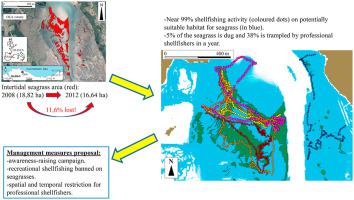当前位置:
X-MOL 学术
›
Estuar. Coastal Shelf Sci.
›
论文详情
Our official English website, www.x-mol.net, welcomes your
feedback! (Note: you will need to create a separate account there.)
Estimated footprint of shellfishing activities in Zostera noltei meadows in a northern Spain estuary: Lessons for management
Estuarine, Coastal and Shelf Science ( IF 2.6 ) Pub Date : 2021-03-15 , DOI: 10.1016/j.ecss.2021.107320 Joxe Mikel Garmendia , Mireia Valle , Ángel Borja , Guillem Chust , José Germán Rodríguez , Javier Franco
Estuarine, Coastal and Shelf Science ( IF 2.6 ) Pub Date : 2021-03-15 , DOI: 10.1016/j.ecss.2021.107320 Joxe Mikel Garmendia , Mireia Valle , Ángel Borja , Guillem Chust , José Germán Rodríguez , Javier Franco

|
Intertidal seagrasses often occupy areas of high ecological importance that are also targeted for human activities, such as shellfishing and leisure walking. These activities could affect the growth or survival of seagrass. The society at large lacks knowledge of the ecological relevance of seagrasses and their vulnerability, presenting an obstacle for their conservation. Here, the Oka estuary (Basque Country, N. Spain) is used as a case study to analyse the spatial extent of shellfishing activities in seagrass (). This estuary holds 84% of the intertidal seagrass meadows present in the Basque Country and is visited during the year by professional and recreational shellfishers. Bait digging is legal year-round, and clam digging (by professionals only) from October to February. Human presence over 11 years averaged 17 people on the tidal flat in each daylight hours from August to October. Each professional shellfishing daily trip affected 7.4–21.6 m by fishing and 110–188 m by trampling in seagrass, but was substantially different between clam and bait (crustacean, worm) fishing. Scaling up this area to estimated annual number of shellfishers, 8–69% of the total seagrass area is trampled and 1–9% is dug per year. In comparison to a habitat suitability map for seagrass, 98% of trampling occurred within a very highly suitable area for seagrass presence (i.e., >90%). This pressure could adversely affect seagrass density and prevent the expansion of meadows into areas suitable for seagrass. Management of public impacts to seagrass in this estuary could occur through prohibition of some activities in seagrass and awareness campaigns among shellfishers and walkers.
中文翻译:

西班牙北部河口大叶藻草甸的贝类捕捞活动足迹估计:管理经验教训
潮间带海草通常占据具有高度生态重要性的区域,这些区域也是人类活动的目标,例如贝类捕捞和休闲散步。这些活动可能会影响海草的生长或生存。整个社会缺乏对海草的生态相关性及其脆弱性的了解,这给海草的保护带来了障碍。这里,以奥卡河口(西班牙北部巴斯克地区)为案例研究,分析海草中贝类捕捞活动的空间范围()。该河口拥有巴斯克地区 84% 的潮间带海草草地,全年都有专业和休闲贝类捕捞者到访。挖饵全年都是合法的,十月至二月期间挖蛤(仅限专业人士)。超过 11 年的人类活动表明,从 8 月到 10 月,每天白天,滩涂上平均有 17 人。每次专业贝类每日行程对捕鱼影响7.4-21.6 m,对海草践踏影响110-188 m,但蛤类和饵料(甲壳类、蠕虫)捕鱼之间存在显着差异。如果将该区域扩大到每年贝类捕捞者的估计数量,每年有 8-69% 的海草总面积被践踏,1-9% 被挖掘。与海草栖息地适宜性地图相比,98% 的践踏发生在非常适合海草存在的区域(即 >90%)。这种压力可能会对海草密度产生不利影响,并阻止草甸扩展到适合海草生长的区域。可以通过禁止某些海草活动以及在贝类捕捞者和步行者中开展宣传活动来管理该河口海草的公众影响。
更新日期:2021-03-15
中文翻译:

西班牙北部河口大叶藻草甸的贝类捕捞活动足迹估计:管理经验教训
潮间带海草通常占据具有高度生态重要性的区域,这些区域也是人类活动的目标,例如贝类捕捞和休闲散步。这些活动可能会影响海草的生长或生存。整个社会缺乏对海草的生态相关性及其脆弱性的了解,这给海草的保护带来了障碍。这里,以奥卡河口(西班牙北部巴斯克地区)为案例研究,分析海草中贝类捕捞活动的空间范围()。该河口拥有巴斯克地区 84% 的潮间带海草草地,全年都有专业和休闲贝类捕捞者到访。挖饵全年都是合法的,十月至二月期间挖蛤(仅限专业人士)。超过 11 年的人类活动表明,从 8 月到 10 月,每天白天,滩涂上平均有 17 人。每次专业贝类每日行程对捕鱼影响7.4-21.6 m,对海草践踏影响110-188 m,但蛤类和饵料(甲壳类、蠕虫)捕鱼之间存在显着差异。如果将该区域扩大到每年贝类捕捞者的估计数量,每年有 8-69% 的海草总面积被践踏,1-9% 被挖掘。与海草栖息地适宜性地图相比,98% 的践踏发生在非常适合海草存在的区域(即 >90%)。这种压力可能会对海草密度产生不利影响,并阻止草甸扩展到适合海草生长的区域。可以通过禁止某些海草活动以及在贝类捕捞者和步行者中开展宣传活动来管理该河口海草的公众影响。











































 京公网安备 11010802027423号
京公网安备 11010802027423号